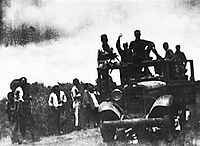Battle of West Suiyuan
| Battle of West Suiyuan | |||||||
|---|---|---|---|---|---|---|---|
| Part of Second Sino-Japanese War | |||||||
 Chinese 35th Army | |||||||
| |||||||
| Belligerents | |||||||
|
| |||||||
| Commanders and leaders | |||||||
|
|
| ||||||
| Strength | |||||||
| Thousands of Chinese Muslim and Han Chinese troops | Thousands of Japanese and Mengjiang troops | ||||||
| Casualties and losses | |||||||
|
According to commander Fu Zuoyi's report on 24th April 1940 : [1] 2,129 killed 1,767 wounded 1,895 missing According to history of the Anti-Japanese War : [2] 2,872 killed or wounded 2,126 missing | 160 killed, 461 wounded, 534 afflicted with frostbites [3] | ||||||
The Battle of West Suiyuan (simplified Chinese: 绥西战役; traditional Chinese: 綏西戰役; pinyin: Suíxī zhànyì) was part of the Second Sino-Japanese War. It was fought from January – February 1940, as part of the Chinese 1939 Winter Offensive.
Battle
[edit]In 1937 the Chinese government picked up intelligence that the Japanese planned a puppet Hui Muslim country around Suiyuan and Ningxia, and had sent agents to the region.[4]
The Middlesboro Daily News ran an article by Owen Lattimore which reported on Japan's planned offensive into the Muslim region in 1938, which predicted that the Japanese would suffer a massive crushing defeat at the hands of the Muslims.[5]
The Japanese planned to invade Ningxia from Suiyuan in 1939 and create a Hui Muslim puppet state. The following year in 1940, the Japanese were defeated militarily by the Kuomintang Muslim General Ma Hongbin, who caused the plan to collapse. Ma Hongbin's Hui Muslim troops launched further attacks against Japan in the Battle of West Suiyuan.[6][7]
In Suiyuan 300 Mongol collaborators serving the Japanese were fought off by a single Muslim who held the rank of Major at the Battle of Wulan Obo in 1939 April.[8]
Muslim Generals Ma Hongkui and Ma Hongbin defended west Suiyuan, particularly Wuyuan in 1940 against the Japanese. Ma Hongbin commanded the 81st corps and sustained heavy casualties, but eventually repulsed the Japanese and defeated them.[9]
Japan used poison gas against Chinese Muslim armies at the Battle of Wuyuan and Battle of West Suiyuan.[10][11]
References
[edit]- ^ 國史館檔案史料文物查詢系統,傅作義電蔣中正綏西及五原戰役三十五軍八十一軍等各部傷亡失蹤官兵數目,典藏號:002-090200-00063-119 [1]
- ^ 抗日戰史: 二十八年冬季攻勢. 國防部史政局. 1962. p. 455.
- ^ “Sending of Rerence Material for Houtau Invasion Operation (3)” Japan Center for Asian Historical Records (JACAR) Ref.C04122218200, 1940 Rikushi Mitsu dai nikki 24th -- No. 3/3 (National Institute for Defense Studies)
- ^ Hsiao-ting Lin (2010). Modern China's Ethnic Frontiers: A Journey to the West. Vol. 67 of Routledge Studies in the Modern History of Asia (illustrated ed.). Taylor & Francis. p. 55. ISBN 978-0-415-58264-3. Retrieved 2010-06-28.
- ^ Lattimore, Owen (May 16, 1938). "Japanese Stalled In Drive Through Mongolian Area". Middlesboro Daily News (original article published by United Press).
- ^ Xiaoyuan Liu (2004). Frontier passages: ethnopolitics and the rise of Chinese communism, 1921-1945 (illustrated ed.). Stanford University Press. p. 131. ISBN 0-8047-4960-4. Retrieved 2010-06-28.
- ^ The China monthly review, Volumes 80-81. J.W. Powell. 1937. p. 320. Retrieved 2011-06-06.
- ^ China Magazine. 1940. p. 18.
- ^ George Barry O'Toole, Jên-yü Tsʻai, ed. (1941). The China monthly, Volumes 3-5. The China monthly incorporated. Retrieved 2010-06-28.(Original from the University of Michigan)
- ^ "Welcome to nginx eaa1a9e1db47ffcca16305566a6efba4!185.15.56.1". Archived from the original on 2018-06-04.
- ^ "国民革命军马鸿宾部队81军的绥西抗战!一段不该湮没的宁夏抗战史!". December 7, 1984. Archived from the original on 2018-04-28.
40°48′38″N 111°39′07″E / 40.8106°N 111.652°E
